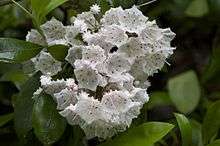Kalmia
| Kalmia | |
|---|---|
 | |
| Kalmia latifolia | |
| Scientific classification | |
| Kingdom: | Plantae |
| (unranked): | Angiosperms |
| (unranked): | Eudicots |
| (unranked): | Asterids |
| Order: | Ericales |
| Family: | Ericaceae |
| Genus: | Kalmia L. |
| Species | |
|
See text. | |
Kalmia is a genus of about 8 species of evergreen shrubs from 0.2–5 m tall, in the family Ericaceae. They are native to North America (mainly in the eastern half of the continent) and Cuba. They grow in acidic soils, with different species in wet acid bog habitats (K. angustifolia, K. polifolia) and dry, sandy soils (K. ericoides, K. latifolia).
Kalmia was named by Linnaeus to honour his friend the botanist Pehr Kalm, who collected it in eastern North America during the mid-18th century. Earlier Mark Catesby saw it during his travels in Carolina, and after his return to England in 1726, imported seeds. He described it, a costly rarity, in his Natural History of Carolina, as Chamaedaphne foliis tini, that is to say "with leaves like the Laurustinus"; the botanist and plant-collector Peter Collinson, who had begged some of the shrub from his correspondent John Custis in Virginia, wrote, when his plants flowered, that "I Really Think it exceeds the Laurus Tinus."[1]
The leaves are 2–12 cm long and simple lanceolate. The flowers are white, pink or purple, in corymbs of 10-50, reminiscent of Rhododendron flowers but flatter, with a star-like calyx of five conjoined petals; each flower is 1–3 cm diameter. The fruit is a five-lobed capsule, which splits to release the numerous small seeds.
The foliage is toxic if eaten, with sheep being particularly prone to poisoning, hence the name lambkill used for some of the species. Other names for Kalmia, particularly Kalmia angustifolia, are sheep-laurel, lamb-kill, calf-kill, kill-kid, and sheep-poison,[2] which may be written with or without the hyphen. (See species list below.) "Kid" here refers to a young goat, not a human child, but the foliage and twigs are toxic to humans as well.
It has also been called spoonwood because Kalm was told by Dutch settlers of North America that Native Americans made spoons from the wood.[3] Given its toxicity, this may be folklore rather than scientific fact.
Kalmias are popular garden shrubs, grown for their decorative flowers. They should not be planted where they are accessible to livestock due to the toxicity.
Kalmia species are used as food plants by the larvae of some lepidopteran species including Coleophora kalmiella which feeds exclusively on Kalmia.
Species
- Kalmia angustifolia L. - Sheep-laurel, Lambkill
- Kalmia buxifolia (Bergius) Gift & Kron - Sandmyrtle
- Kalmia carolina Small - Carolina Mountain-laurel
- Kalmia cuneata Michx. - Whitewicky
- Kalmia ericoides Wright - Cuban Kalmia
- Kalmia hirsuta Walt. - Hairy Mountain-laurel
- Kalmia latifolia L. - Mountain-laurel, Lambkill
- Kalmia microphylla (Hook.) A. Heller - Alpine laurel, Alpine Bog-laurel, Alpine Mountain-laurel, sometimes considered a variety or subspecies of Kalmia polifolia [4]
- Kalmia occidentalis Small - Synonymous with Kalmia microphylla [4]
- Kalmia polifolia Wangenh. - Bog Kalmia, Bog-laurel
- Kalmia procumbens (L.) Gift & Kron - Alpine azalea
The related Kalmiopsis (Kalmiopsis leachiana) is a rare shrub native to the Siskiyou Mountains of southwest Oregon.
Bibliography
Books
- Jaynes, Richard A., 1997: Kalmia, mountain laurel and related species, Timber Press, Portland, Oregon, U.S.A.
References
- ↑ Alice M. Coats, Garden Shrubs and Their Histories (1964) 1992, s.v. "Kalmia".
- ↑ Natural History Education, Science, Technology regarding alternate names, accessed March 30, 2007.
- ↑ Plants of Colonial Days by Raymond Leech Taylor, p. 61. (1996) ISBN 0-486-29404-8. Accessed March 30, 2007.
- 1 2 http://plants.usda.gov/java/profile?symbol=KAMI